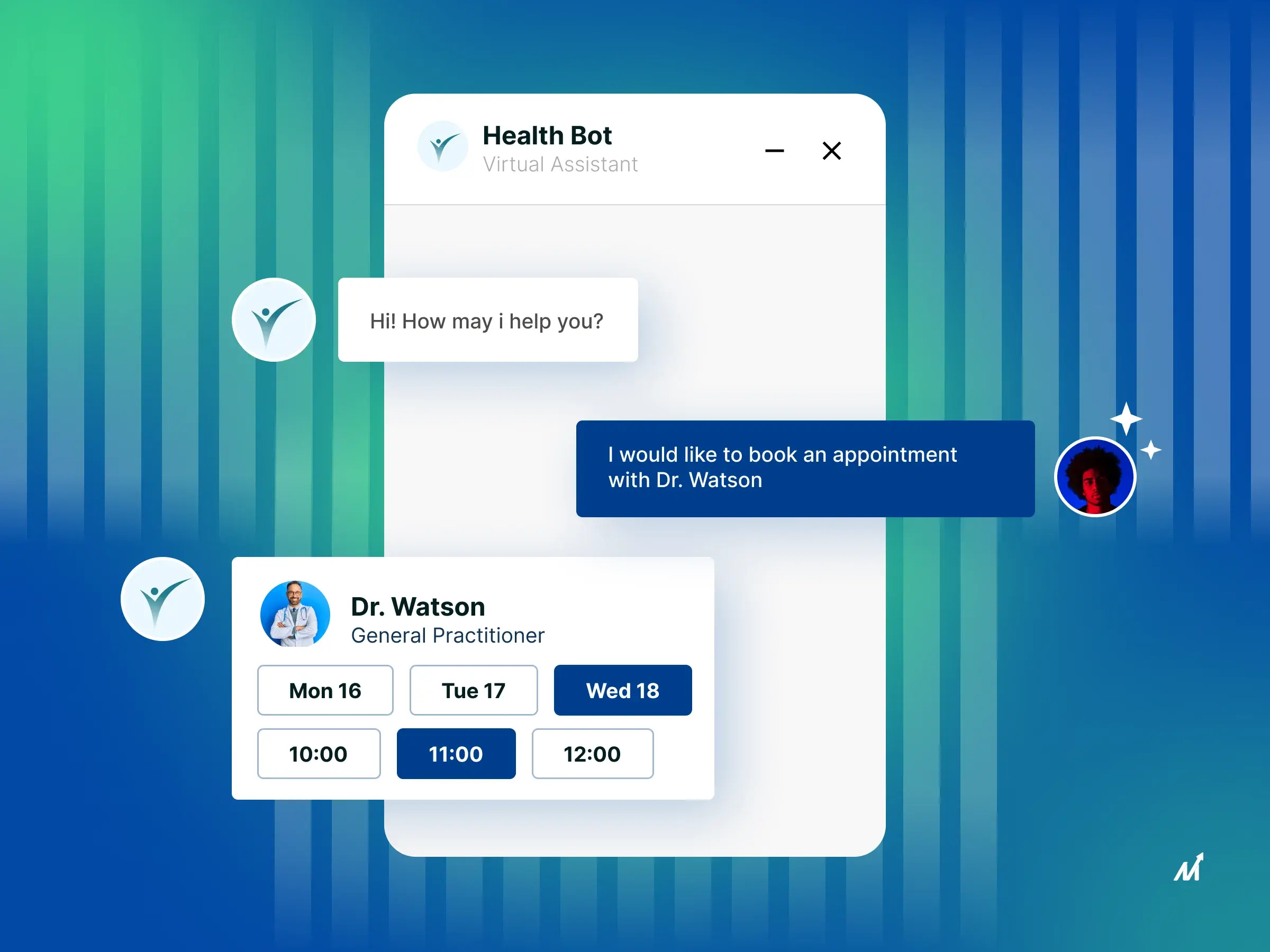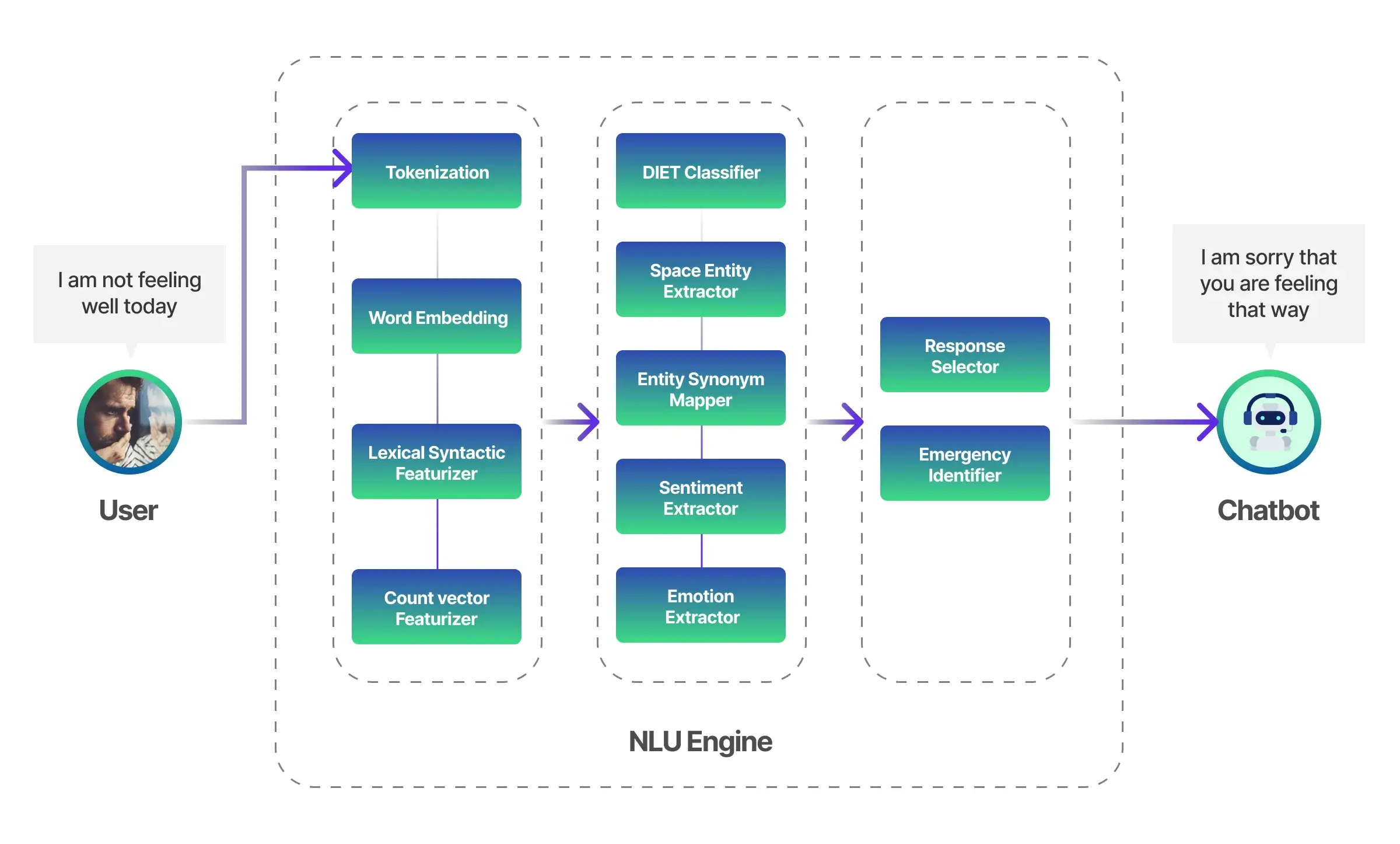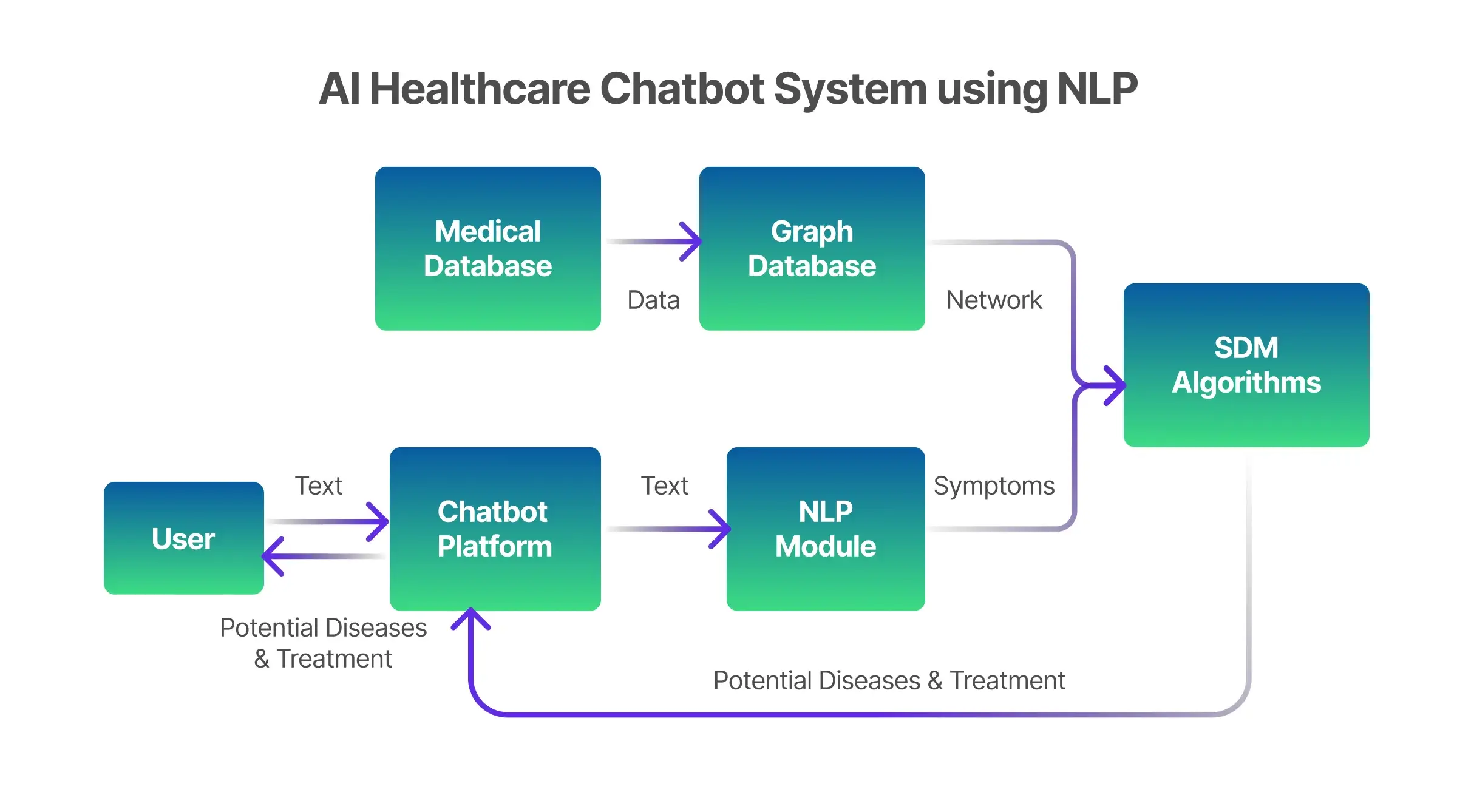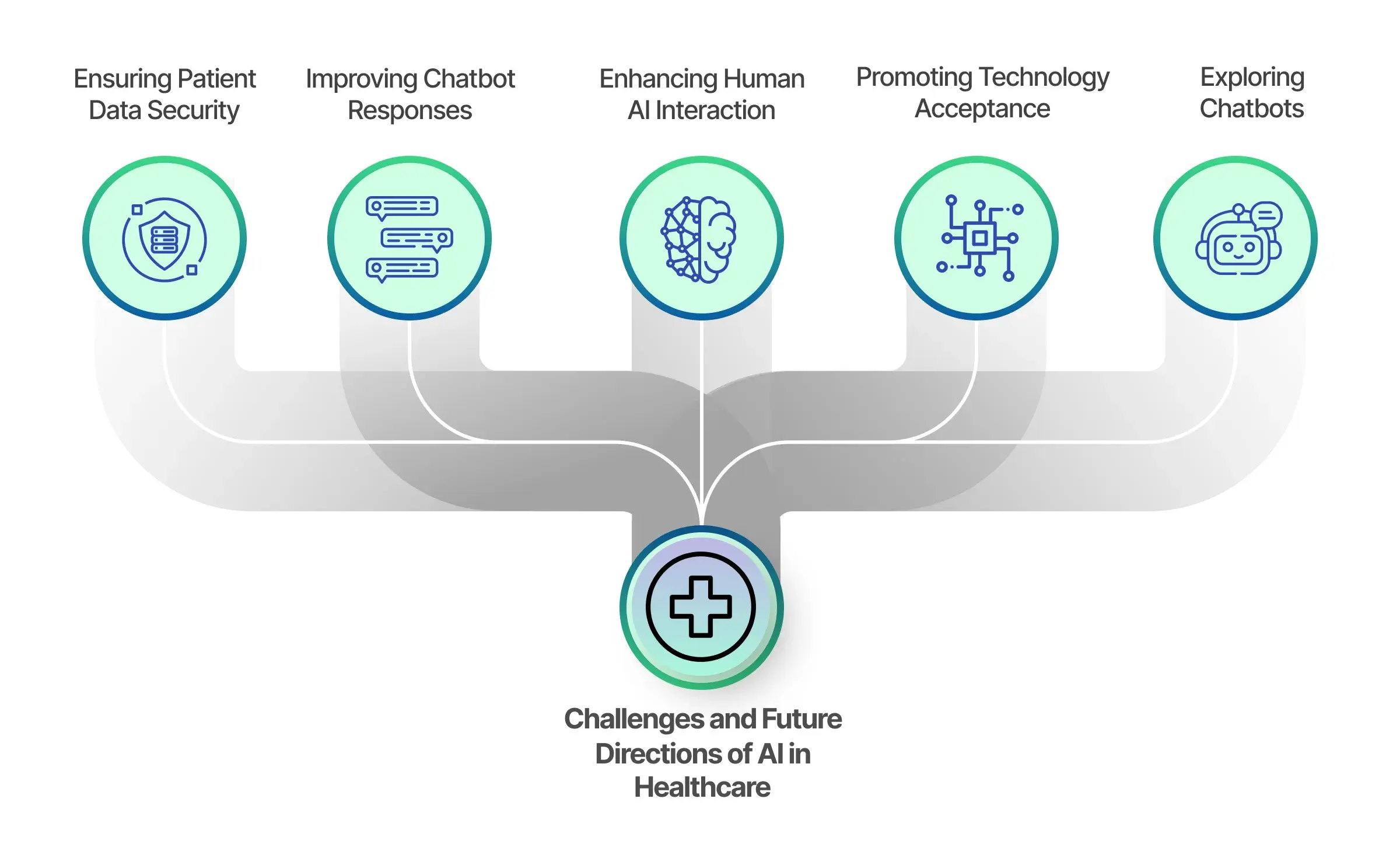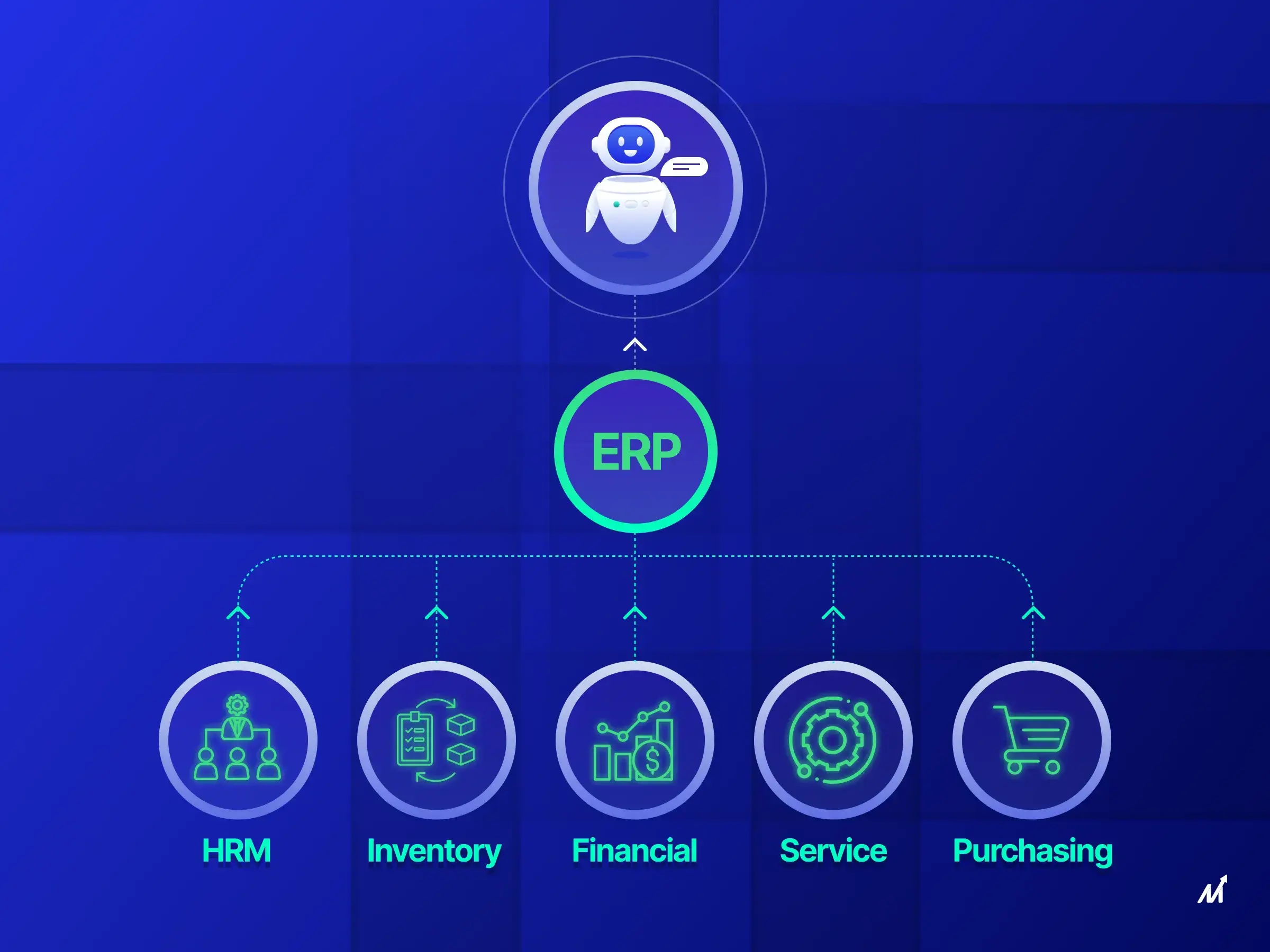Chatbots have become crucial in revolutionizing the healthcare industry by utilizing Artificial Intelligence (AI) and Natural Language Processing (NLP). These virtual assistants provide support, improve engagement, streamline care delivery, and ultimately lower healthcare costs. In the following sections, we will explore the aspects. Share real-life examples that highlight the significant impact of chatbots in healthcare.
Chatbots powered by AI and NLP utilize machine learning algorithms to comprehend and respond to user queries. Their role in healthcare is expanding rapidly, as there is an increasing need for personalized and efficient patient care. For instance, the Babylon Health chatbot offers advice based on users’ symptoms, demonstrating how these technologies can potentially transform patient engagement.
Benefits of Chatbots in Healthcare
Enhanced Patient Engagement
Availability 24/7 for Patient Support and Access to Information
Implementation: Develop a chatbot system equipped with monitoring and AI algorithms to handle queries around the clock.
Business Impact: Ensures support and addresses patient concerns promptly, potentially reducing emergency room visits while enhancing patient satisfaction.
Personalized Guidance and Self-Care Assistance
Technical Implementation: Implement a chatbot system that provides tailored guidance for patients’ needs, empowering them with self-care knowledge.
The chatbot system can provide personalized health advice that considers histories by leveraging the power of machine learning algorithms and integrating patient data.
The impact on the business is significant as it enhances trust by delivering tailored recommendations. In turn, this can lead to adherence to treatment plans. It has improved health outcomes.
Improved Patient Satisfaction and Compliance with Treatment Plans
Improve customer satisfaction and compliance with treatment plans by implementing sentiment analysis algorithms. It will help gauge patient satisfaction and can tailor their responses accordingly.
It will impact the business as higher patient satisfaction contributes to word of mouth. Improve the overall reputation of healthcare providers.
Improved Care Delivery:
Streamlined Administrative Tasks and Scheduling Processes:
To enhance care delivery, streamline tasks, and schedule processes. It can help achieve this by implementing a chatbot with process automation capabilities. The chatbot will interface with organizing systems and electronic health records (EHR). The benefit to the business is reducing overhead. By doing so, our staff can focus on critical tasks, potentially increasing operational efficiency.
Reduced Workload for Healthcare Professionals:
Another advantage is reducing the workload for healthcare professionals. Develop a chatbot to handle inquiries and administrative tasks.
It will allow healthcare professionals to concentrate on care and complex medical decisions. The potential impact is significant; it frees up professionals’ time, reduces burnout, and improves staff satisfaction.
Enhanced Efficiency and Quality of Care:
Lastly, incorporating decision support algorithms into the chatbot will aid in processes and treatment planning. This technical implementation will enhance the efficiency and quality of care provided.
Business Impact: Using chatbots in healthcare can improve accuracy and faster care delivery, potentially reducing the time and resources needed for management.
Reduced Healthcare Costs
Automating interactions and reducing the workload of staff chatbots can reduce healthcare costs associated with labor. Hence, it allows for the reallocation of resources to patient care areas.
Automation Implementation
Process automation, machine learning, and natural language processing techniques automate interactions. These technologies enable chatbots to handle tasks.
Cost Savings for Healthcare Organizations
Implementing analytics tools that measure the cost savings achieved through chatbot implementation can provide insights. Demonstrating benefits attracts investment and improves the overall financial health of healthcare organizations.
Increased Access to Care for Underserved Populations
Developing a chatbot through devices and internet connections makes healthcare services available to more individuals. This approach enhances accessibility, reduces healthcare disparities, and supports initiatives that positively impact an organization’s brand.
In summary, integrating chatbots into healthcare operations involves leveraging capabilities to enhance patient engagement, streamline care delivery processes, reduce costs associated with labor-intensive tasks, and improve overall efficiency.
Integrating intelligence (AI) machine learning and automation technologies enhances operational efficiency and positions healthcare organizations as technologically advanced and patient-centric entities in the competitive healthcare landscape.
Examples of Chatbot Applications in Healthcare
Patient Self Care Support
Personalized Health Information and Education
Utilize machine learning algorithms to analyze patients’ health data and provide tailored information based on their histories.
Use Case: A diabetic patient receives personalized educational content about their condition, including dietary advice and exercise recommendations.
Self-Care Tips and Symptom Management Guidance
Implementation: Deploy a chatbot with natural language processing capabilities to understand user symptoms and offer self-care guidance.
Use Case: A user experiencing cold symptoms receives tips on home remedies, managing symptoms, and guidance on when to seek professional medical assistance.
Chronic Disease Management and Medication Adherence Support
Implementation: Integrate with health records (EHR) to monitor indicators of chronic diseases and provide medication reminders.
Use Case: A patient with hypertension receives medication reminders, lifestyle recommendations, and periodic check-ins to monitor their blood pressure levels.
Appointment Scheduling and Management
Online Appointment. Management
Technical Implementation;
Let’s develop a chatbot that can be integrated with the healthcare providers’ appointment scheduling system, making it easier for patients to book their appointments online.
Use Case: A scenario where a patient wants to schedule a follow-up appointment. They can use the chatbot, which will provide them with time slots and confirmation details.
Appointment Reminders and Directions to Healthcare Facilities
Use geolocation services to send appointment reminders and provide directions to the healthcare facility. This way, patients will receive reminders along with maps, reducing the chances of missed appointments.
Reduction of Wait Times and Improved Scheduling Efficiency
To improve efficiency further, incorporate predictive analytics into the chatbot. Analyzing data can suggest appointment slots that minimize wait times and better use resources.
Symptom Triage and Guidance
Initial Assessment of Patient Symptoms and Potential Causes
Another helpful feature would be symptom triage and guidance. Through AI algorithms, the chatbot can. Categorize user-reported symptoms, assessing potential causes, like indigestion or more severe conditions.
Guidance on Appropriate Actions, Such as Seeking Medical Attention or Self-Care
Additionally, by integrating decision support algorithms, the chatbot can guide users on actions based on symptom severity. It will help users decide whether to seek attention or practice self-care measures.
Use Case: The chatbot can guide and support users experiencing flu symptoms, offering advice on self-care measures they can take at home. However, if a user exhibits symptoms, the chatbot encourages them to seek medical attention.
Reducing Unnecessary Visits to Emergency Departments
Technical Implementation: The chatbot can identify patterns by leveraging health data and machine learning algorithms. Effectively guide users away from unnecessary visits to emergency rooms.
Use Case: The chatbot assists users with urgent symptoms by redirecting them to primary care providers or facilities. Subsequently, it helps alleviate congestion in emergency departments.
Refill Reminders
Medication reminders and refill requests
Technical Implementation: The chatbot connects with pharmacy systems to send medication reminders and facilitate user refill requests.
Use Case: The chatbot supports patients with conditions by providing reminders for medication doses. Additionally, it allows them to request refills conveniently through the platform.
Tracking Medication. Alerting Potential Adverse Effects
Technical Implementation: By integrating with health records (EHR), the chatbot can keep track of a user’s medication history. It also alerts for effects that may arise from interactions between prescribed medications.
Use Case: The chatbot plays a role in alerting users about interactions between their prescribed medications. It offers guidance on how they can mitigate risks associated with effects.
Promoting Medication Adherence and Enhancing Safety
Technical Implementation: The chatbot encourages users to consistently adhere to their medication regimen, leveraging nudges and messaging techniques. This approach aims at promoting safety in medication management.
Use Case: As a reward system, the chatbot. Rewards users who demonstrate adherence to their prescribed medications. This positive reinforcement helps improve safety in medication management.
Supporting Mental Health and Providing Resources
Strategies for Emotional Support and Coping with Mental Health Concerns
Implementation: Utilize sentiment analysis to offer evidence-based coping techniques through an interface.
For example, When someone is dealing with anxiety, they can receive understanding responses, coping strategies, and encouragement to seek help.
Connecting People with Mental Health Resources and Support Groups
Implementation: Integrate with health information databases to provide details about support groups and resources.
For example, The chatbot helps someone experiencing depression by connecting them with support groups and mental health experts, fostering a sense of community.
Promoting Well-being. Raising Awareness about Mental Health
Implementation: Regularly check in on health status. Share educational content to promote overall well-being.
For example, During periods, the chatbot starts conversations on stress management, promoting awareness of health challenges and building resilience.
Incorporating these features into chatbot applications can enhance patient experience while reducing burdens. Ultimately, this contributes to improved healthcare outcomes. These examples illustrate how versatile chatbots are in addressing healthcare needs.
Essential Factors to Consider for Chatbot Implementation
Natural Language Processing (NLP)
Ensuring Accurate Comprehension of Patient Language and Intent
Technical Approach: Utilize NLP models, like BERT and GPT 3, to interpret user input considering the context and intent accurately.
Ability to Handle Complex Medical Terminology and Address Patient Queries
Technical Approach: Create a medical knowledge base combined with NLP models to handle complex medical terms effectively and provide accurate responses to patient inquiries.
Designing Conversational Flow
Creating Engaging and User Friendly Conversational Experiences
Technical Approach: Incorporate design principles considering user experience (UX) and user interface (UI) design to develop engaging interactions.
Customizing Dialogues for Patient Requirements and Preferences
Technical Approach: Implement dialogue branching based on user responses, adapting the conversation flow to meet diverse patient needs and preferences.
Integration with Healthcare Systems
Seamless Integration with Existing Electronic Health Records (EHR)
Technical Approach: Develop interfaces that seamlessly connect with EHR systems, enabling the chatbot to access and update patient records in time.
Secure Data Exchange and Protection of Patient Privacy
Technical Approach: Implement data exchange protocols such as HL7 or FHIR and encryption mechanisms, ensuring data safeguarding during transmission and storage.
Privacy
Implementing Strong Data Security Measures and Privacy Protocols
Technical Implementation: Utilize encryption, access controls, and secure server configurations to protect data from unauthorized access.
Ensuring Compliance with Healthcare Data Privacy Regulations
Technical Implementation: Regularly update the chatbot protocols to adhere to evolving healthcare data privacy regulations, such as HIPAA or GDPR.
Addressing Privacy Concerns and Ensuring Patient Data Security
Technical Strategies: Continuously invest in encryption technologies, implement authentication mechanisms, and conduct security audits to address emerging privacy concerns.
Improving Accuracy and Reliability of Chatbot Responses
Technical Strategies:
- Train the machine learning model using real-world data.
- Encourage user feedback for model improvement.
- Integrate external knowledge databases to enhance accuracy.
Enhancing Human AI Interaction and Supporting Human Care
Technical Strategies: Foster an approach where chatbots work alongside healthcare professionals, enabling handovers for complex cases and incorporating AI-driven decision support into human workflows.
Promoting Technology Acceptance Among Healthcare Providers and Patients
Technical Strategies: Invest in training programs for healthcare providers to familiarize them with chatbot functionalities, prioritize user interfaces, and actively seek user feedback.
Exploring Exciting and New Applications of Chatbots in Healthcare
Technical Approaches: Continuously researching and implementing emerging technologies like augmented reality (AR) or virtual reality (VR) to expand the applications of chatbots, exploring analytics for medicine, and staying at the forefront of technological innovation.
Expertise in Developing Healthcare Chatbots at Markovate
At Markovate, our approach to developing healthcare chatbots revolves around understanding the healthcare industry’s patient requirements and regulatory standards. We adopt a process by working with healthcare providers and stakeholders to ensure that the chatbots we create fulfill their specific needs and objectives.
We are committed to developing chatbots that enhance patient engagement, improve care delivery, and ultimately contribute to patient outcomes. Chatbots have the potential to revolutionize healthcare by providing personalized and efficient support to patients whenever they need it.
Our Services for Implementing Healthcare Chatbots:
- Chatbot Strategy and Design
- Chatbot Development
- Chatbot Integration
- Chatbot Deployment and Support
We are passionate about assisting healthcare organizations in leveraging AIs’ power to transform patient care and achieve their goals.
Conclusion:
Reiterating the transformative potential of chatbots in healthcare, the technical considerations discussed are crucial for successful implementation. Emphasizing the importance of addressing challenges and ensuring responsible performance underscores the commitment to patient safety, data security, and effective healthcare delivery. Expressing optimism about the future of chatbots acknowledges the dynamic nature of technology and its ongoing role in shaping the healthcare landscape for improved patient outcomes and experiences.

